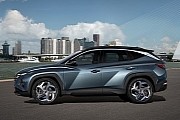PRODUCTION MODELS : 25
Hyundai is a self-grown South Korean brand of automobiles established in the 1960's. Presently part of the Hyundai Kia Automotive Group, the motor company has registered a steady growth over the past few decades, having successfully entered European and American markets. The assembly lines operated by the company were built to match its size, the manufacturing facility in Ulsan being able to produce 1.6 million units per year.
Founded by Chung Ju Yung, born into a poor family of farmers, the Hyundai Motor Company became the first Korean car producer. The grounds for founding a car company could not have been more welcoming since post-war years in Korea brought forth a series of odd politics one of which stated that automobile imports were better than having a Korean car brand.
Yung was quick to fill the void, having raised enough capital for the investment from his very profitable construction business, opened in 1947. One year after its birth, the Hyundai Motor Company signed a technology-share agreement with Ford in 1968. Soon after Hyundai's access to Ford's resources, the first Hyundai car was developed: the Cortina. This model was quickly followed by the release of the Pony, Hyundai's first entirely Korean designed and built model. Its blueprints however, were not all-Korean, the company having used Japanese technology from Mitsubishi to develop the car.
Japanese constructors at the time had already developed wide range of models, many of which were exported worldwide, mainly to the US and South America. The Pony model was the first Hyundai to be shipped overseas in 1975.
However, Hyundai would only cross US borders later, in 1986, with the release of the Excel. The subcompact car was an instant hit with its fairly small price tag accounting for most of its popularity. The Excel was such a hit that it sold in over 100,00 units in the first seven months.
This was the last automobile that Hyundai produced before resorting to their own technology in 1988. The Sonata was their first born, a mid-seize car that marked the beginning of a new era. Despite the steps the company had taken into building a strong brand image, the reputation Hyundai had previously collected was lost because of poor quality and reliability complaints.
As soon as the 90's came, Hyundai was short of air on American territory, struggling for one last gasp. Instead of retreating, the company made massive investments in new design and technology. By the time the new millennium came, the company had already reinstated as one quality car manufacturer.
Sales increased once more and with them so did the buyer's confidence in Hyundai. The sudden shift in consumer behavior was made possible by eliminating all worries regarding the vehicle's reliability through the introduction of a 10 year warranty to US sold vehicles only. Since few companies could top that, Hyundai quickly earned a spot in the world's top -10 car manufacturers.
Hyundai is currently operating in 193 countries, selling vehicles through approximately 5,000 showrooms and dealerships. Sales have also aided image growth, the brand having entered the first 100 most valuable brands of the world. Its recent history is strongly connected to investments in technology and ample advertising campaigns. Indeed, communication is one of Hyundai's inherent elements, best described by their logo: the stylized H is in fact a representation of two men (brand-buyer) shaking hands.
4 GENERATIONS
2020 - PRESENT5 GENERATIONS
2020 - PRESENT10 GENERATIONS
2020 - PRESENT5 GENERATIONS
2020 - PRESENT6 GENERATIONS
2020 - PRESENT5 GENERATIONS
2019 - PRESENT2 GENERATIONS
2019 - PRESENT2 GENERATIONS
2019 - PRESENT11 GENERATIONS
2019 - PRESENT3 GENERATIONS
2018 - PRESENT2 GENERATIONS
2018 - PRESENT7 GENERATIONS
2020 - PRESENT2 GENERATIONS
2018 - PRESENT6 GENERATIONS
2017 - PRESENT3 GENERATIONS
2017 - PRESENT3 GENERATIONS
2017 - PRESENT3 GENERATIONS
2012 - PRESENT2 GENERATIONS
2018 - PRESENT1 GENERATION
2014 - PRESENT1 GENERATION
2019 - PRESENT1 GENERATION
2020 - PRESENT1 GENERATION
2012 - PRESENT1 GENERATION
2018 - PRESENT1 GENERATION
2017 - PRESENT1 GENERATION
2019 - PRESENT

























Comments
Post a Comment